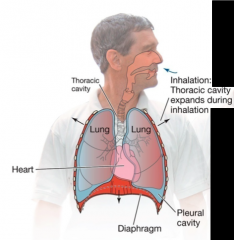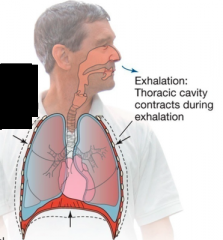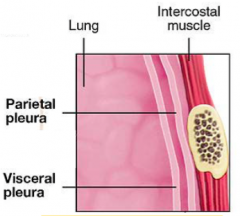![]()
![]()
![]()
Use LEFT and RIGHT arrow keys to navigate between flashcards;
Use UP and DOWN arrow keys to flip the card;
H to show hint;
A reads text to speech;
17 Cards in this Set
- Front
- Back
|
how is breathing controlled ? |
- medulla is the major center that controls breathing - determines, depth, altitude and frequency of breathing - phrenic nerve : controls contraction & lowering of diaphragm - efferent nerve (spinal motor neurons) : activates intercostal muscles - aortic and carotid bodies are sensitive to the decrease of PO2 - chemoreceptor at the ventral surface of the medulla is sensitive to the increase in PCO2 |
|
|
the influence of CO2 on breathing ? |
- CO2 is the trigger point for the action of breathing to be initiated - aortic body and carotid bodies are not that sensitive to the decrease in O2 compare the the level of CO2 - usually has to be drastic decrease for it to start reacting - involuntary (can be voluntary) |
|
|
What happens during hypoxia (short term) , and how can people overcome it . |
- at high altitude, O2 level is reduced, causing animals to hyperventilate - as chemoreceptors (aortic and carotid bodies) are activated to maintain sufficient O2 delivery - aquatic hypoxia, causing gill to ventilate more frequently due to stimulation of chemoreceptors in the gills |
|
|
What happens to body when exposed to hypoxia in long term ? |
1. reset threshold of the chemoreceptors for oxygen. It will be more sensitive to the low level of oxygen 2. increase the number of RBC and blood haemoglobin content (increase blood's capacity for oxygen) |
|
|
What triggers the proliferation of RBC ? and what are the functions of proliferation of RBC. |
- long term exposure to environment with low oxygen levels - reduction in blood O2 stimulates production of erythropoietin (EPO) in kidney and liver - it acts on bone marrow and stimulates its production of RBC - it is widely used in sports to elevate sportsman's performance - it can be done naturally or through injection of synthesised erythropoietin |
|
|
what is "shallow water blackout" ? describe the situation that could cause this and explain the mechanism behind it. |
- it is due to voluntary (intentional) hyperventilation - usually happens for swimmer - they hyperventilate to get more oxygen into the system - however, it also removed many carbon dioxide - lowering the level of CO2 in body - oxygen will deplete when swimmer is underwater and CO2 levels will increase - however, due to the lowering of CO2 at the start it will not reach the triggering point to trigger breathing action before oxygen level depletes to a minimum level - thus blackouts kicks in |
|
|
what does Tibetans do to regulate breathing in high altitude ? |
- breath more frequently - more breaths per minutes compare to normal people |
|
|
what is lung surfactant ? give an example of when it is important. |
- it is a phospholipoprotein secreted by some alveoli cells - it reduce the surface tension of the liquid on the alveoli - inters reduce force needed to constrict and expand the lung - make lung more elastic - for new borne babies, before birth, hormone will be released to trigger the production of surfactant to prepare them for breathing - thus, for premature babies, they will have problems breathing as surfactants are not released yet to prepare them for breathing |
|
|
what happens during inhalation ? |

- diaphragm contracts and is pulled downwards together with pleural membrane - external intercostal muscle contracts and push the rib out - interms pulled on the lung causing increase in thoracic cavity volume - which lowers the pressure in the cavity and draws in air (as the environment has higher pressure) |
|
|
What happens during exhalation ? |

- diaphragm relaxed and arched upwards - elastic lung tissues pulls the diaphragm back up as well - internal intercostal contract pushing the rib back - reduced thoracic cavity volume, increase pressure - air travels out of the lung (lower pressure out side the body) |
|
|
what is pleural membrane ? what is its function ? |

- it consists of parietal and visceral membranes - they are actually one single membrane folded into two - they cover the pleural cavity and cover each lung and the thoracic cavity - they serve as lubricant, which gives smooth sliding when inhale and exhale - also they serve as air-tight-seal, that allows pressure change to happen efficiently |
|
|
list two diseases related to respiratory problems . |
1. smoker's cough 2. cystic fibrosis |
|
|
what is the cause of cystic fibrosis ? |
- accumulation of mucus leading to potential infection due to malfunction os chloride channel - due to the malfunction of chloride channels, chloride can not be moved out of the cell in to the cavity - water concentration cannot be created, thus water will not move of the cell washing away the mucus and trapped dirt and microorganisms - obstruction of airway and paralysis of cilia function - leading to infections |
|
|
How does smoker's cough come about ? |
- smoking immobilise cilia of the airway for hours - it cannot beat the mucus escalator - mucus obstructs airway - infection can happen easily |
|
|
what is the mechanism of ventilation in fish that allow unidirectional flow of water ? |
1. sequential opening & closing of the mouth and operculum 2. a smell pressure difference between the buccal and opercular cavities |
|
|
Describe the special respiratory feature of Mudskipper. |
- specialised "reinforced" gills that doesn't collapse in the air, allowing limited gas exchange when out of water - they live in the interfacial surface between H2O and land . |
|
|
Describe the special respiratory feature in Armored catfish. |
- highly modified and vascularised intestine - used for gas exchange out of water - capillaries are lose to the guts and allows gaseous exchange - air is swallowed and later expelled from anus |

